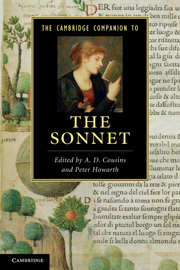Book contents
- Frontmatter
- Introduction
- 1 Contemporary poets and the sonnet
- 2 The sonnet and the lyric mode
- 3 The sonnet, subjectivity and gender
- 4 The English sonnet in manuscript, print and mass media
- 5 European beginnings and transmissions
- 6 Desire, discontent, parody
- 7 Shakespeare’s Sonnets
- 8 Sacred desire, forms of belief
- 9 Survival and change: the sonnet from Milton to the Romantics
- 10 The Romantic sonnet
- 11 The Victorian sonnet
- 12 The modern sonnet
- 13 The contemporary sonnet
- Further reading
- Index
13 - The contemporary sonnet
Published online by Cambridge University Press: 28 May 2011
- Frontmatter
- Introduction
- 1 Contemporary poets and the sonnet
- 2 The sonnet and the lyric mode
- 3 The sonnet, subjectivity and gender
- 4 The English sonnet in manuscript, print and mass media
- 5 European beginnings and transmissions
- 6 Desire, discontent, parody
- 7 Shakespeare’s Sonnets
- 8 Sacred desire, forms of belief
- 9 Survival and change: the sonnet from Milton to the Romantics
- 10 The Romantic sonnet
- 11 The Victorian sonnet
- 12 The modern sonnet
- 13 The contemporary sonnet
- Further reading
- Index
Summary
There are more kinds of beetles than kinds of sonnets, more beetles on earth than sonnets by living authors, but sometimes it seems a close call. Poets writing in English over the last half-century have produced extravagantly traditional sonnets about beauty and about cruelty; sixteen-line sonnets modelled on George Meredith’s Modern Love; sonnets in blank verse; sonnets on love erotic, parental and filial; a political sonnet in Miltonic pastiche; a sonnet composed entirely of clichés; a sonnet history of Glasgow; sonnets spoken by Bruce Wayne as Batman; ‘sonnets’ without words presented as conceptual art; sonnets called ‘Sonnet’ in demotic, unrhymed free verse; sonnets on Japanese-American subjects with haiku for the final couplet; sonnets that tell historical stories for children; a widely lauded literary novel in tetrameter sonnets modelled on Alexander Pushkin’s Eugene Onegin; sonnets in Newfoundland dialect; a crown of fifteen sonnets about e-Bay; and a sonnet in which each line ends on a different letter but all the lines rhyme with ‘oh’. Not only have poets kept on writing sonnets; readers, and publishers, have continued to seek them, to set them apart in collections of their own, from the useful, comprehensive website www.sonnets.org (now twelve years old), to all-sonnet journals such as 14, to The Making of a Sonnet: A Norton Anthology, by the American poet Edward Hirsch and the Irish poet Eavan Boland. Many of the poems Boland and Hirsch include – and many of those described above – would not, a hundred years ago, have been called sonnets at all; some might not have been called poems.
- Type
- Chapter
- Information
- The Cambridge Companion to the Sonnet , pp. 245 - 266Publisher: Cambridge University PressPrint publication year: 2011
- 1
- Cited by

